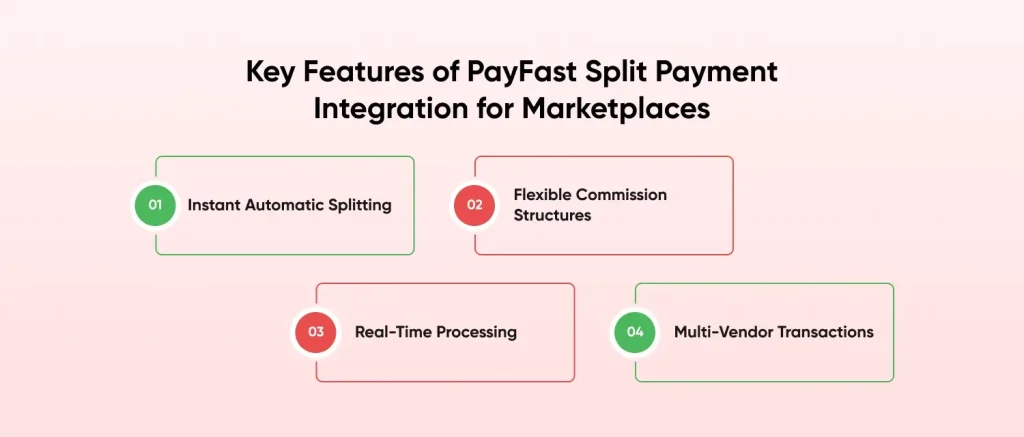Quick Summary: This blog explores how to set up and manage split payments in a multi-vendor marketplace using PayFast. It covers key features, real-world use cases, integration steps, and best practices of Payfast split payments. We also see how it is ideal for South African e-commerce platforms looking to streamline payments and scale efficiently.
The South African e-commerce landscape is experiencing unprecedented growth. However, traditional payment processing methods are not able to keep up with the growing demands of multi-vendor platforms. These challenges include manual commission splitting, complex reconciliation processes and delayed payment processes that cause bottlenecks for both marketplace owners and their vendors.
Marketplace payment solution with PayFast help solve these pain points with ease. This guide dives deep into how PayFast for eCommerce marketplaces transforms payment processing, including practical payment implementation strategies, real-world use cases and professional insights for building successful platform businesses.
According to Statista, the ecommerce market size is expected to grow with a CAGR of 9.49% from 2025-2029, resulting in an estimated market volume of USD 10.52bn in 2029.
Whether you’re planning to build a two-sided marketplace or optimize existing operations, this guide provides actionable solutions for your payment infrastructure needs.
What Are Split Payments and Why Do Marketplaces Need Them?
Split payments automatically divide transaction amounts between multiple parties in real-time. This innovation reduces administrative overhead drastically. Consider a basic marketplace transaction where a customer purchases a product for R1000. The marketplace charges a 10% commission (R100), so the vendor receives R900 for the deal. Traditional platforms will need to make manual calculations, separate transfers, and complex reconciliation processes.
PayFast split payments take care of everything automatically. As soon as a customer makes a payment, the system processes it and immediately splits the funds based on rules you’ve set up in advance. This automation cuts down the processing time dramatically, from a few days to just seconds.
The Traditional Multi-Vendor Marketplace Challenge
Cash Flow Problems
Multi-vendor payment processing presents unique obstacles that standard payment gateways cannot address effectively. Manual commission splitting causes cash flow problems for marketplace operators.
Scale Complexity Issues
These challenges become more complex as platforms scale. A marketplace with 100 vendors processing 1000 transactions monthly faces 100,000 individual calculations. Manual processing becomes impossible, leading to errors and delayed payouts.
Trust and Transparency Barriers
When vendors cannot track their earnings in real-time, it raises trust issues. Transparency becomes crucial for maintaining healthy vendor relationships and platform growth.
Use Cases of E-Commerce and Platform Businesses Marketplace Payment Solution with PayFast
E-commerce and Service Platforms
PayFast for platform businesses addresses numerous use cases across different industries. Online marketplaces benefit from automatic commission splitting between multiple sellers. Service platforms like tutoring or consulting networks use split payments for instructor commissions.
Affiliate and Membership Models
Affiliate and referral programs use PayFast for instant commission distribution. Membership platforms split fees between content creators and platform operators. These applications demonstrate the versatility of split payment integration Payfast.
Key Features of PayFast Split Payment Integration for Marketplaces

1. Instant Automatic Splitting
Wholesale payment splitting Payfast is a complete payment solution for all use cases and requirements of marketplace operators. The system supports instant automatic splitting across different payment methods like credit cards, EFT, and QR codes. Giving this flexibility to customers wins their trust, and provides the convenience of paying using their trusted methods.
2. Flexible Commission Structures
The platform provides different commission structures as well for merchants. You can set up percentage-based or fixed-amount splitting options. Marketplace operators are able to configure complex rule-based transaction types, vendor categories, or product classifications.
3. Real-Time Processing
With real-time transaction processing, payments are completed instantly. The vendors receive their funds in real-time without delay. This improves cash flow.
4. Multi-Vendor Transactions
With PayFast, customers can purchase products from different sellers all at once, and checkout with ease. The system automatically splits the payment between the vendors, which removes the hassle of manual calculations or taking follow-ups.
Technical Benefits of Split Payments for Marketplaces
API Integration Solutions
PayFast delivers flexible integration options through its RESTful API. Developers can work with any programming languages and frameworks, and the clear documentation helps speed up the implementation process.
Payment Method Support
PayFast supports all major South African payment methods, including credit cards, debit cards, instant EFT, QR codes, store cards, and others. Customers can use the payment options they are most comfortable with.
Reporting and Analytics
Transaction reporting and analytics help marketplace operators monitor performance. Real-time dashboards display commission distributions, vendor earnings, and platform revenue. These insights support data-driven decision making.
Understanding How PayFast Manages Split Payments in Marketplaces
The Technical Flow
Payment Initialization
The customer initiates a purchase using the marketplace interface. They are then redirected to PayFast secure payment environment.
Real-Time Processing and Distribution
PayFast processes the payment using the customer’s chosen method. Simultaneously, the system applies predefined splitting rules to calculate commission distributions. These calculations happen instantly, without manual intervention.
Automatic Fund Distribution
Multiple parties receive their portions simultaneously. The marketplace operator receives their commission, while vendors get their share. Transaction confirmations and receipts are generated automatically for all parties.
Setting Up Split Rules In PayFast
Percentage-Based Splitting
Percentage-based splitting offers the most common configuration option. Marketplace operators define commission percentages for different vendor categories or product types. The system automatically calculates amounts based on transaction values.
Fixed-Amount Allocations
Fixed-amount allocations are a great fit for things like membership charges or listing fees. The platform will deduct a fixed amount from the payment, and split the rest. It’s a simple and effective way to manage earnings on platforms that use a mix of revenue models.
Complex Multi-Party Splits
Complex multi-party splits enable sophisticated commission structures. Platforms can distribute funds between vendors, affiliates, payment processors, and platform operators. This flexibility supports various business models and partnership arrangements.
Integration Steps for PayFast Split Payments in Multi-Vendor Marketplaces
API Setup and Testing
Payment API integration development services help marketplace operators implement split payments efficiently. The process begins with API key generation and sandbox environment setup. Developers can test functionality before going live.
Key Integration Points
Key integration points include payment initialization, webhook handling, and transaction status monitoring. Proper error handling ensures robust operation under various conditions. Testing procedures validate split calculations and fund distributions.
Sandbox Environment Benefits
The sandbox environment provides safe testing space for complex scenarios. Developers can simulate various transaction types and splitting rules. This testing phase prevents issues during live operations.
Step-by-Step Guide to Implement Split Payment Marketplace Solution with PayFast
Here is a complete run-through of building a multi-vendor eCommerce marketplace. Let’s start with the prerequisites.
Account Requirements
To implement split payments successfully, a bit of preparation goes a long way.
- Start with an active PayFast merchant account that supports split payments.
- Make sure split payment functionality is enabled before integration.
- Complete the required account verification steps to stay compliant with financial regulations.
- Proper setup helps avoid payment delays and ensures smooth transactions.
Technical Specifications
- Use a secure hosting environment and make sure SSL certificates are in place to protect transactions.
- Developers should be familiar with RESTful APIs and know how to work with webhooks.
- A proper understanding of multi-vendor payment processing PayFast helps avoid common mistakes during setup.
Business Planning
- Define your commission structures in advance to keep transactions consistent and transparent.
- Plan out the vendor onboarding process to make setup smooth for new sellers.
- Provide clear documentation so vendors know how their earnings are calculated and when they’ll get paid.
- Good preparation helps reduce confusion and cuts down on support requests later.
Troubleshooting PayFast Split Payments: Common Pitfalls & Fixes
| Issue | Description | Best Practice / Fix |
| Failed Payment Management | Split payments can fail due to temporary issues like network errors or declined cards. | Use automatic retry mechanisms and clearly communicate with customers about the issue and resolution. |
| Account Verification Issues | If a vendor’s PayFast account isn’t verified, payments can’t be processed successfully. | Ensure all vendors complete their PayFast setup. Automate verification to reduce administrative workload. |
| Refund Processing Complexity | Refunds are more complicated when multiple parties are involved, as each must receive a fair share. | Build logic for proportional refunds and clearly communicate refund policies to prevent disputes. |
Real-World Marketplace Payment Solution with PayFast
1. Marketplace Scenarios
Multi-Vendor E-commerce Platforms
Multi-vendor e-commerce platforms represent the most common use case for split payments. These marketplaces connect numerous sellers with customers seeking diverse products. Automatic commission splitting eliminates manual processing for thousands of transactions.
Service Marketplaces
Service marketplaces benefit significantly from instant payment distribution. Tutoring platforms can pay instructors immediately after lesson completion. Consulting networks distribute fees between consultants and platform operators seamlessly.
Digital Product Marketplaces
Digital product marketplaces can use split payments to easily manage payouts for content creators. Whether it’s an author, designer, or developer, they get paid instantly when their product is sold. This kind of quick, hassle-free compensation helps boost satisfaction and keeps top creators coming back.
2. Real-World Applications
Educational Platforms
Educational platforms demonstrate split payment effectiveness in service industries. Students pay for courses while instructors receive automatic commission distributions. Platform operators earn fees without manual processing overhead.
Estate Agency Groups
Estate agency groups use split payments for commission distribution between agents and brokers. Property transactions trigger automatic commission splits based on predefined agreements. This automation eliminates disputes and accelerates payments.
Community Marketplaces
Community marketplaces leverage split payments for local commerce. Vendors receive payments instantly while platform operators earn commissions. This speed advantage encourages vendor participation and platform growth.

PayFast vs International E-commerce Marketplace Payment Gateways
PayFast vs Stripe Connect
Stripe Connect provides many similar features like PayFast for international markets. However, South African merchants face higher fees and complex currency conversions. PayFast’s local focus provides cost advantages and better customer support.
PayFast vs PayPal for Marketplaces
While PayPal is widely used around the world, it doesn’t always cater to local preferences. In South Africa, many customers prefer trusted local payment methods such as EFT or store cards, which PayFast supports. That local touch can significantly improve conversion rates and customer satisfaction.
Regulatory Compliance Advantages
Navigating South African financial regulations can be challenging, especially for international providers. PayFast, being locally based, has a strong understanding of these rules. This helps businesses stay compliant, avoid legal issues, and develop a stable foundation for long-term success.
Why PayFast is Preferred over International E-commerce Marketplace Gateways In South Africa?
Local Payment Method Support
Local payment method support differentiates PayFast from international competitors. South African customers trust familiar options like Mobicred and store cards. This trust leads to higher conversion rates.
Transparent Pricing Structure
Pricing structures favor local merchants with transparent fee schedules. PayFast eliminates hidden currency conversion fees and all international transaction charges.
Local Customer Support
Customer support availability during South African business hours improves problem resolution. Local support teams understand regional payment preferences and regulatory requirements. This expertise accelerates issue resolution and implementation support.
Best Practices for Marketplace Payment Management
1. Financial Management
Accounting Systems Integration
Proper accounting systems integration helps improve financial reporting accuracy. Split payments generate multiple transaction records requiring careful tracking. Modern accounting software can automate these processes through API integrations.
Streamlined Refund and Dispute Resolution
Managing refunds and disputes is no easy feat in a multi-vendor marketplace. Automated systems like PayFast step in to facilitate a smoother process that preserves positive vendor relationships and reduces operational friction.
2. Vendor Management
Streamlined Onboarding
Unlike international gateways that often have complex, lengthy onboarding processes, PayFast makes it straightforward for South African vendors to get started. Local vendors can complete payment setup and verification quickly, without dealing with foreign banking complications. Being upfront about commission structures builds trust from day one, and automated onboarding means less administrative burden compared to international alternatives that often require manual payment processing.
Payout Schedule Management
PayFast understands the cash flow needs of South African businesses better than international gateways. Local vendors can plan their finances more effectively with reliable payout schedules. The ability to offer instant payments through split payment systems gives vendors faster access to their money which is something that international gateways often struggle with due to cross-border processing delays. Clear communication about processing times and fees maintains transparency that local businesses value.
Account Verification Procedures
PayFast’s local account verification process is designed for South African businesses, making it much smoother than international gateways that often don’t understand local banking requirements. Vendors can complete their PayFast account setup using familiar local banking details and processes. Automated verification reduces the delays and complications that often come with international systems trying to verify South African accounts, resulting in fewer support issues and faster go-live times.
3. Technical Best Practices
Robust Error Handling
Error handling implementation prevents payment failures and customer frustration. Robust retry mechanisms manage temporary network issues. Clear error messages help customers resolve problems quickly.
Monitoring and Alerts
Monitoring and alert systems help identify payment issues proactively. Real-time dashboards display transaction success rates and error frequencies. These insights enable quick problem resolution and system optimization.
API Rate Management
Managing API rate limits is key to keeping your system running smoothly, especially during busy periods. By controlling the number of requests sent at once, you can avoid slowdowns or service interruptions. This kind of stability is especially important during peak shopping seasons when traffic is high.
Transparent Fee Communication
Clear, upfront fee structures build trust with both customers and vendors on your marketplace. When everyone knows exactly what commission rates and processing fees they’ll be paying, it prevents disputes and misunderstandings later on. This transparency strengthens your platform’s reputation and improves vendor retention – people prefer working with platforms that are honest about costs rather than springing surprise fees on them.
Mobile-First Design
With more people shopping and doing business on their mobile devices, having optimized payment flows isn’t just nice to have anymore, it’s essential. When your payment process works smoothly across all screen sizes, customers are more likely to complete their purchases instead of abandoning their carts out of frustration. This responsive design approach directly boosts conversion rates, which becomes increasingly important as mobile commerce continues to dominate the market. It is ideal to opt for reliable mobile app development services to make your platform mobile-first and friendly.
4. Edge Case Handling
Edge case handling prevents customer frustration during unusual scenarios. Partial refunds, payment failures, and account issues require careful consideration. Proactive handling of these situations maintains customer satisfaction.
Split Payment Setup Checklist: Marketplace Implementation with PayFast
Before going live with your PayFast multi-vendor payment processing, make sure these critical steps are completed to avoid technical or financial issues:
| Task | Description |
| Merchant Account Approval | Register and activate a PayFast merchant account with split payment functionality. |
| Define Commission Models | Use platform logic to plan percentage-based or fixed commission splits. |
| Sandbox Testing Complete | Simulate various transaction flows using test vendors and webhooks. |
| API Credentials & Webhooks Set Up | Secure your API keys and configure webhook endpoints to listen for payment status updates. |
| Configure Split Rules | Create flexible rules for product-based, vendor-based, or category-based commissions. |
| Legal & Tax Compliance | Align your payout flows with local VAT rules and legal guidelines. |
| Account Verification for Vendors | Ensure all vendors have PayFast accounts linked and verified. |
| Integrate with Backend Systems | Sync transactions with accounting software and inventory/order systems. |
| UX Testing on All Devices | Test checkout flows across desktop and mobile to ensure responsive performance. |
| Include Documentation for Vendors | Provide transparent policies and earnings breakdowns for every transaction. |
Once your PayFast API for split payments is implemented successfully, you can start processing real transactions with confidence. If needed, consult experts in payment API integration development services or hire dedicated developers to handle complex backend scenarios.
The Future of Platform Businesses & What’s Coming Next in Fintech
Platform Economy on the Rise
The platform economy keeps growing at an impressive pace. New marketplaces are popping up all the time, which means there’s a real need for payment solutions that can keep up. This growth is pushing demand for more sophisticated ways to handle payments – businesses want systems that can do more than just process basic transactions.
Emerging Payment Technologies
People are getting more comfortable with newer payment methods like digital wallets and cryptocurrencies. The key is having payment systems that are able to adapt and integrate these new technologies as they become mainstream. Flexibility in payment processing isn’t just nice to have anymore but it’s what keeps businesses relevant as the market evolves.
Regulatory Evolution
Payment processing requirements are constantly shifting as regulators update their rules. Local payment providers have the advantage here because they understand these changes and can pivot quickly when needed. This kind of agility gives them a real edge over international alternatives that might be slower to adapt to local regulatory shifts.
Wrapping It All Up
When you’re ready to add split payments to your platform, working with developers who really know what they’re doing makes a world of difference. A professional web development services provider can help you avoid the common pitfalls and get everything up and running much faster than trying to figure it out on your own.
As online shopping continues to change and grow, having the right payment tools becomes absolutely critical. You need systems that can handle the complexity automatically while still feeling natural and familiar to your local customers. Getting this right from the start saves you countless headaches down the road.
FAQs on Marketplace Payment Solution with Payfast
How to Manage Marketplace Transactions with Payfast?
Enable PayFast’s Split Payments feature through Settings > Integration in your dashboard to automatically distribute payments between marketplace owners and vendors. Split Payments allows you to effortlessly split online payments with third parties and streamline financial payments, though it’s only available through custom integration.
How Can I Set Up Split Payments in a Marketplace Using Payfast?
Navigate to Settings > Integration in your PayFast dashboard to enable Split Payments, which is available only through custom integration. You’ll need to specify merchant IDs in the payment array to automatically distribute funds to different vendors based on their products.
Is Payfast Suitable for Multi-Vendor Marketplaces?
Yes, PayFast is suitable for multi-vendor marketplaces through their Split Payments functionality. PayFast’s split payments enable linking vendor accounts to their profiles and automating payments to vendors, making it ideal for marketplace platforms with multiple sellers.
How Do Payfast Payments Work?
PayFast integrates 18+ payment methods including credit cards, Instant EFT, QR codes, and store cards with no setup or monthly fees. Users are redirected to PayFast’s secure payment page, complete their transaction, then return to your website, with funds processed and paid out within 48-72 hours.







